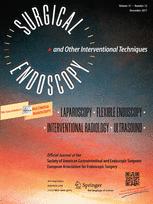Perretta S, Dallemagne B, Allemann P, Marescaux J
Surg Endosc. 2010 Nov;24(11):2903.
BACKGROUND:
It is generally accepted that the most effective treatment of achalasia is a surgical myotomy. Nevertheless, if a myotomy alone is performed, reflux may occur in up to 30% of patients. The aim of this study was to explore a transoral incisionless stepwise approach to both esophageal Heller myotomy and fundoplication.
METHODS:
The first step consisted of creating the esophageal myotomy. Under general anesthesia, with the pig supine, endoscopy was performed to assess the location of the esophagogastric junction (EGJ). The mucosa on the right posterolateral esophageal wall was cut with the needle-knife 15 cm above the lower esophageal sphincter (LES) and then dilated with blunt dissection to introduce the scope. A submucosal tunnel was created distally with CO(2) and blunt dissection. Once the gastroesophageal junction (GEJ) and the clasp fibers were identified, the muscular layer was cut. The scope was withdrawn into the lumen and the mucosal flap was sealed with endoscopic clips. The adequacy of the myotomy was evaluated using pre- and postoperative manometry and by comparing the EGJ distensibility before, during, and after the division of the esophageal muscular fibers using the functional lumen imaging probe, EndoFLIP®. The second step, consisted of building a transoral incisionless fundoplication 4 weeks postoperatively using the EsophyX™.
RESULTS:
Both Heller myotomy and endoscopic fundoplication were accomplished successfully with no injury to the esophageal mucosa. Postoperative manometry demonstrated a 50% loss in mean LES pressure (mean preoperative LES pressure = 22.2 mmHg; mean postoperative LES pressure = 10 mmHg, P < 0.005). The EndoFLIP® showed a preoperative minimal diameter of 6 mm with a cross-sectional area of 28 mm(2). Postoperatively, the junction was more compliant (minimal diameter = 15 mm; cross-sectional area = 177 mm(2)), with the main improvement in distensibility occurring when the clasps fibers were removed.
CONCLUSIONS:
A stepwise transoral incisionless approach to esophageal Heller myotomy and partial fundoplication is feasible and effective in the porcine model. A distensibility test such as the EndoFLIP® may provide better information on the opening and closing dynamics of the EGJ, rather than just relying on the sphincter tonic state as measured by manometry.
Erratum:
Surg Endosc.2010 Nov;24(11):2904. Alleman, P [corrected to Allemann, P].
Link to open access article: Perretta S, et al; Surg Endosc. 2010 Nov;24(11):2903


